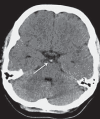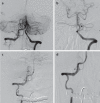Mechanical Thrombectomy in Pregnancy: Report of 2 Cases and Review of the Literature
- PMID: 28611834
- PMCID: PMC5465721
- DOI: 10.1159/000453461
Mechanical Thrombectomy in Pregnancy: Report of 2 Cases and Review of the Literature
Abstract
Background: Mechanical thrombectomy has recently proved extremely effective in improving the outcome of patients with large vessel occlusion. Despite this, questions still remain over certain cohorts of patients that were excluded from the large randomised controlled trials. One such cohort includes pregnant patients. Although thromboembolic stroke is uncommon in pregnancy, the outcome from this pathology can be devastating.
Summary: We present 2 cases of mechanical thrombectomy in pregnancy both of which underwent successful flow restoration without complications. We discuss the incidence of stroke in pregnancy, potential pitfalls of imaging, radiation protection issues, and the role of thrombolysis as well as the available literature on mechanical thrombectomy in this cohort.
Key message: Thrombectomy in pregnancy can be performed safely with no significant changes required to the procedure itself. Radiation exposure during the procedure should be minimised and shielding used to prevent scatter radiation to the fetus; however, given the potential risks of thrombolysis in this cohort of patients, mechanical thrombectomy should be considered in all stages of pregnancy.
Keywords: Mechanical thrombectomy; Pregnancy.
Figures






References
-
- Sharshar T, Lamy C, Mas JL. Incidence and causes of strokes associated with pregnancy and puerperium. A study in public hospitals of Ile de France. Stroke in Pregnancy Study Group. Stroke. 1995;26:930–936. - PubMed
-
- Wiebers DO, Whisnant JP. The incidence of stroke among pregnant women in Rochester, Minn, 1955 through 1979. JAMA. 1985;254:3055–3057. - PubMed
-
- Jaigobin C, Silver FL. Stroke and pregnancy. Stroke. 2000;31:2948–2951. - PubMed
-
- Skidmore FM, Williams LS, Fradkin KD, et al. Presentation, etiology, and outcome of stroke in pregnancy and puerperium. J Stroke Cerebrovasc Dis. 2001;10:1–10. - PubMed
Publication types
LinkOut - more resources
Full Text Sources
Other Literature Sources

